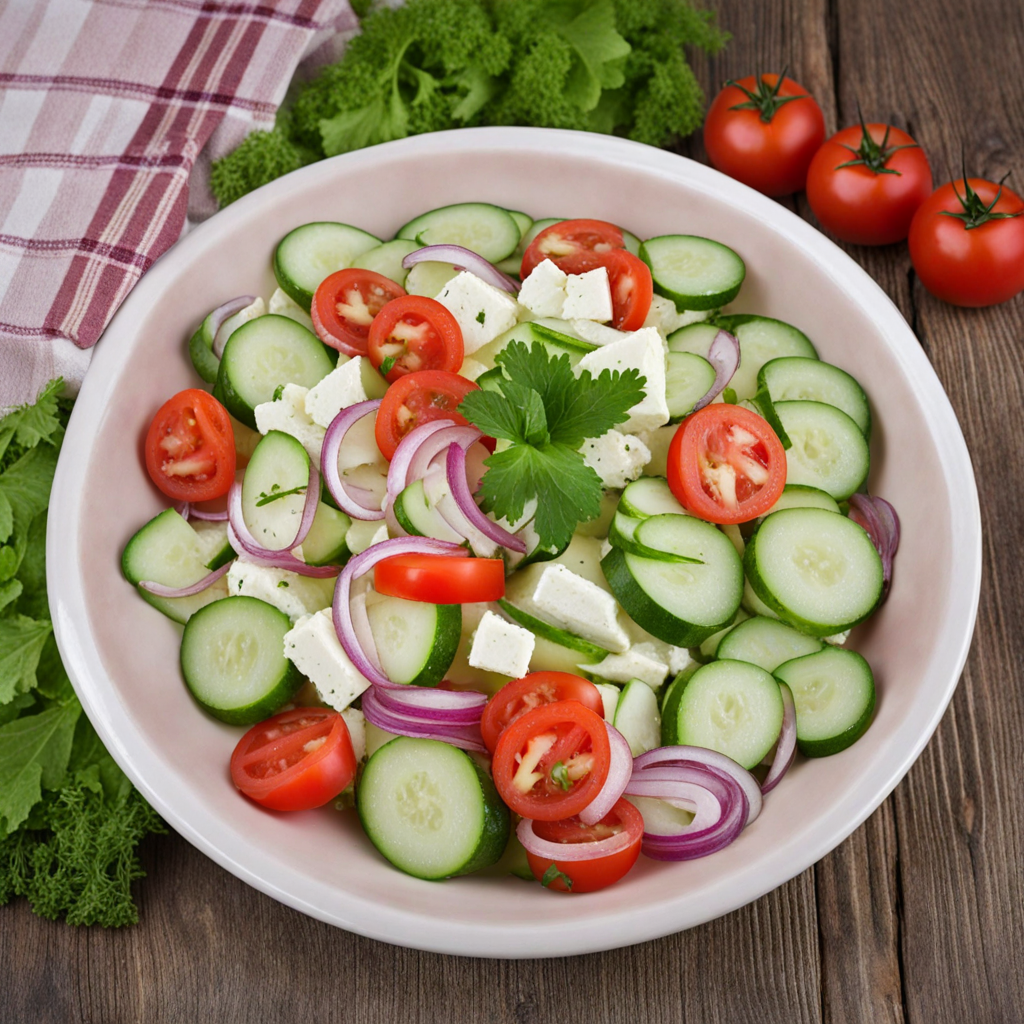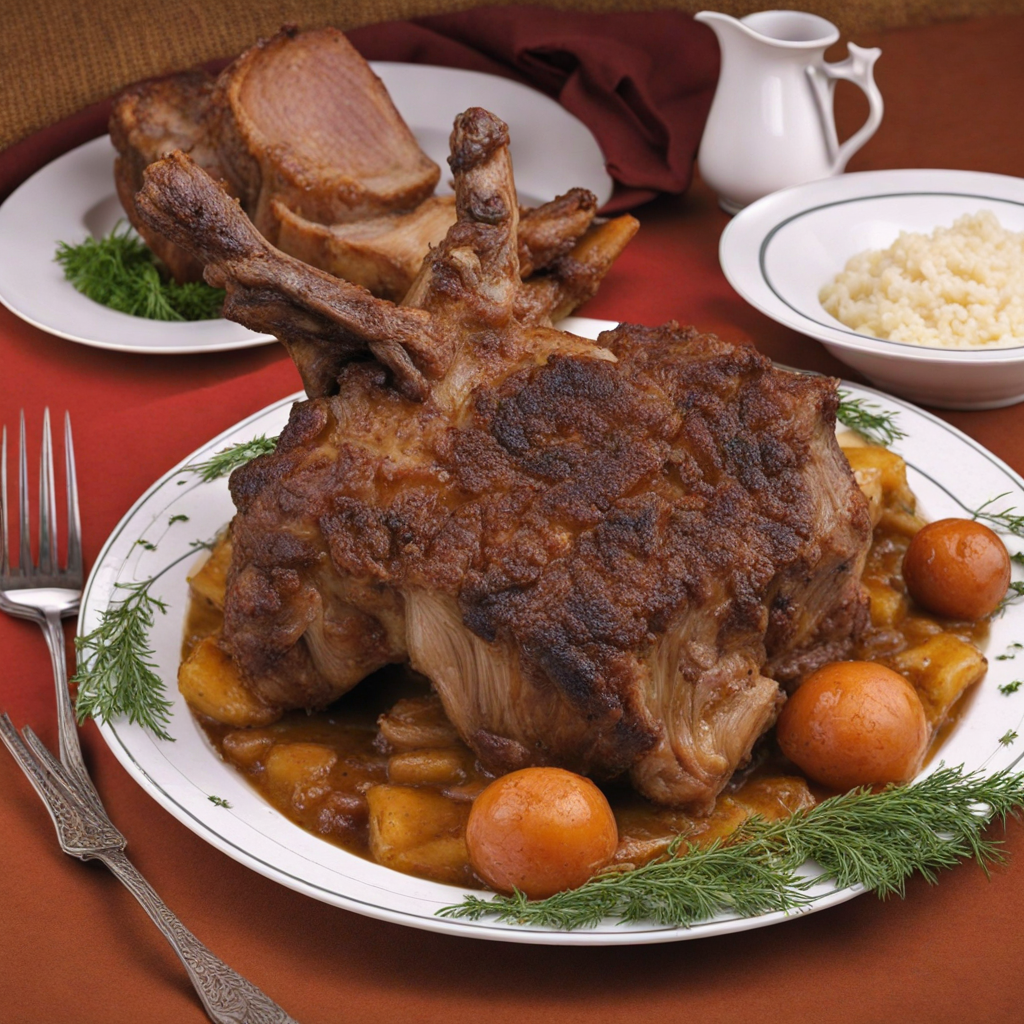Šopska salata
Šopska salata is a vibrant and refreshing salad that originates from the Balkan region, particularly popular in Serbia. This dish is a celebration of fresh ingredients, showcasing a colorful mix of diced tomatoes, cucumbers, and bell peppers, all of which are staples in Serbian cuisine. The vegetables are typically chopped into bite-sized pieces, allowing for a harmonious blend of flavors and textures. The bright colors of the salad not only make it visually appealing but also hint at the freshness and quality of the ingredients used. A key component of Šopska salata is the addition of crumbled feta cheese, which adds a creamy and salty element that perfectly balances the crispness of the vegetables. The salad is usually dressed with a simple mixture of olive oil and vinegar, enhancing the natural flavors without overpowering them. Sometimes, finely chopped onions or garlic are included to add an extra layer of flavor, making each bite a delightful experience. This dish is often enjoyed as a side, complementing grilled meats or served as a light meal on its own. Šopska salata is not just a dish; it embodies the essence of Balkan hospitality and the enjoyment of fresh, wholesome food. It is commonly served during summer gatherings and barbecues, bringing people together to savor its refreshing taste. The combination of textures—from the crunch of the cucumbers to the creaminess of the feta—along with the invigorating flavors, makes Šopska salata a must-try for anyone looking to explore the rich culinary landscape of Serbia. Whether enjoyed as an appetizer or a main course, this salad is sure to awaken your palate and leave you craving more.
How It Became This Dish
The Engaging History of Шопска салата (Shopska Salad) #### Origins Шопска салата, or Shopska salad, is a vibrant and refreshing dish that has become synonymous with Balkan cuisine, particularly in Serbia, Bulgaria, and North Macedonia. Its roots can be traced back to the broader agricultural traditions of the Balkan region, where fresh vegetables and dairy products have long been staples of the local diet. The salad is named after the Šopska region, a historical area that encompasses parts of Bulgaria and Serbia, and reflects the culinary practices of the rural communities living there. The core ingredients of Shopska salad typically include diced tomatoes, cucumbers, bell peppers, onions, and a generous topping of grated white cheese, usually feta or a similar brined cheese. A drizzle of sunflower oil and a sprinkle of vinegar complete the dish, enhancing the freshness of the vegetables. The salad embodies the essence of the Mediterranean diet, emphasizing fresh, seasonal produce and simple preparation methods. #### Cultural Significance Shopska salad is more than just a dish; it represents a cultural identity that transcends national borders. It is a common feature on the tables of many Balkan households, often served as an appetizer or a side dish to complement grilled meats and other hearty meals. The salad's bright colors mirror the lively spirit of the Balkans, where hospitality and communal dining are deeply rooted traditions. In Serbia, Shopska salad is a staple during the summer months, celebrated for its crispness and refreshing qualities. It is often enjoyed outdoors, especially during gatherings, picnics, and barbecues. The salad's simplicity allows it to be prepared quickly, making it a favorite among home cooks. Its presence at celebrations and family feasts underscores its role in bringing people together, serving as a reminder of the importance of shared meals in fostering connections. #### Development Over Time The history of Shopska salad is intertwined with the agricultural practices and culinary exchanges of the Balkan region. Its emergence can be traced back to the late 19th and early 20th centuries, coinciding with the rise of national cuisines and identities following the decline of the Ottoman Empire. As the people of the Balkans sought to reclaim and celebrate their culinary heritage, dishes like Shopska salad gained prominence. During this time, the salad began to evolve, adapting to local tastes and available ingredients. The introduction of new vegetable varieties, such as the bell pepper, further enriched the dish. The use of local cheese, often made from sheep's milk, added a distinct flavor profile that set Shopska salad apart from other Mediterranean salads. This adaptability helped the dish to thrive, as it was embraced not only in households but also in restaurants and taverns. In the mid-20th century, Shopska salad became a symbol of Yugoslav cuisine, celebrated for its wholesomeness and simplicity. It was featured prominently in various culinary festivals and events, highlighting the region's rich agricultural bounty. The salad's popularity spread beyond national borders, leading to variations in neighboring countries. Each nation has its interpretation, yet the fundamental elements remain consistent, showcasing the shared culinary heritage of the Balkans. The rise of tourism in the late 20th century also contributed to the widespread recognition of Shopska salad. As visitors flocked to the region, they were introduced to its vibrant flavors and colorful presentation. Restaurants began to showcase the dish as a signature offering, further solidifying its status as a culinary ambassador of Balkan culture. Its inclusion in menus across Europe and beyond has helped to popularize the salad internationally, allowing it to reach global audiences. #### Modern Adaptations In contemporary times, Shopska salad continues to evolve while remaining rooted in tradition. Chefs and home cooks alike experiment with variations, incorporating ingredients such as olives, avocado, or herbs like parsley and mint. These adaptations reflect the ongoing exchange of culinary ideas and the influence of global food trends on local dishes. Health-conscious consumers have also embraced Shopska salad for its nutritional benefits. Rich in vitamins, minerals, and antioxidants, the salad aligns well with modern dietary preferences, making it a popular choice for those seeking lighter, plant-based options. Its vibrant colors and fresh ingredients make it visually appealing, further enhancing its allure in a world increasingly focused on aesthetics in food. Despite these modern adaptations, the essence of Shopska salad remains unchanged. It is still a dish that celebrates the bounty of the land and the importance of community. Whether served at a family gathering, a festive celebration, or a casual meal, Shopska salad embodies the spirit of togetherness that is central to Balkan culture. #### Conclusion In conclusion, Шопска салата (Shopska salad) is much more than a mere combination of vegetables and cheese. Its rich history reflects the agricultural practices, cultural traditions, and culinary ingenuity of the Balkan region. From its origins in the Šopska region to its status as a beloved dish in Serbian and broader Balkan cuisine, Shopska salad has traversed time and borders, adapting and evolving while retaining its core identity. As it continues to be enjoyed by generations of families and food enthusiasts, Shopska salad stands as a testament to the enduring power of food to connect people, celebrate culture, and honor the land. Whether enjoyed in the heart of Serbia or shared among friends in a distant city, this salad serves as a delicious reminder of the rich culinary heritage that binds us all.
You may like
Discover local flavors from Serbia







